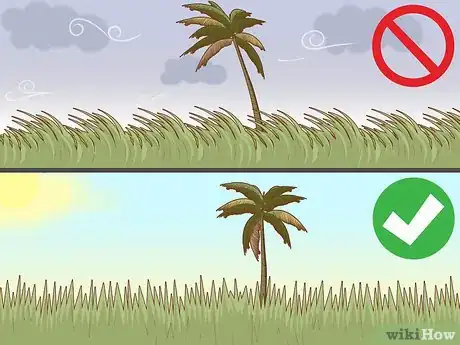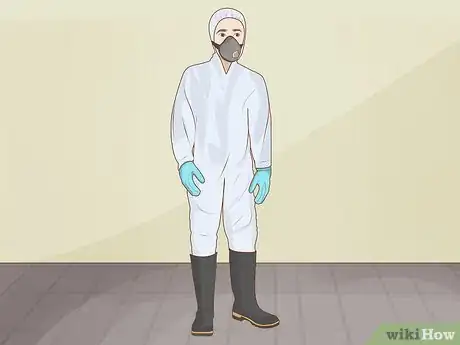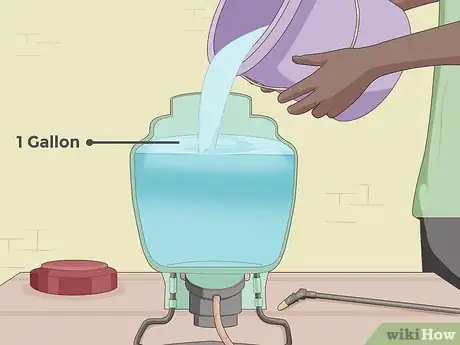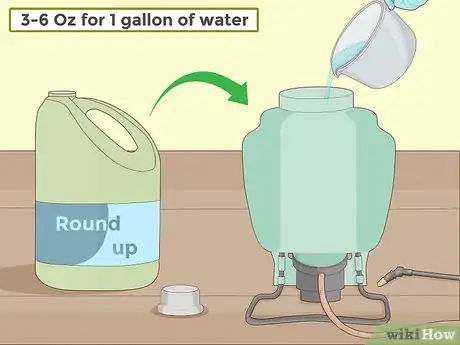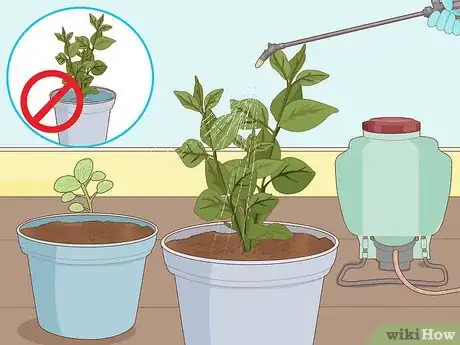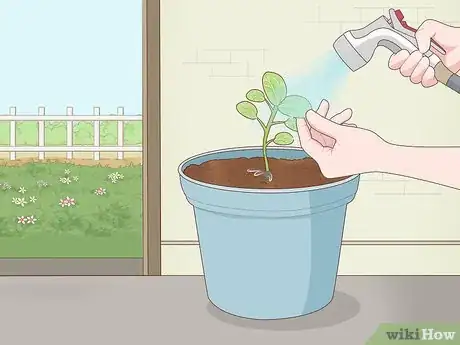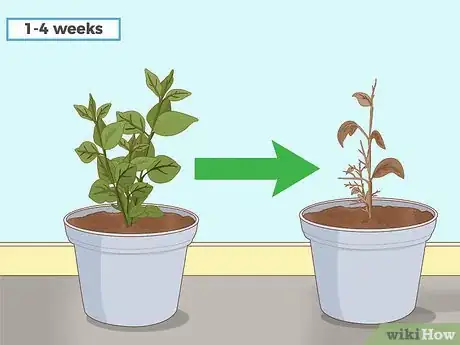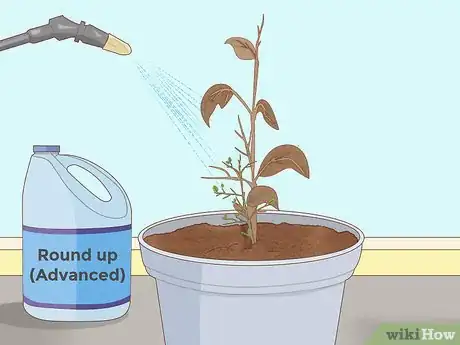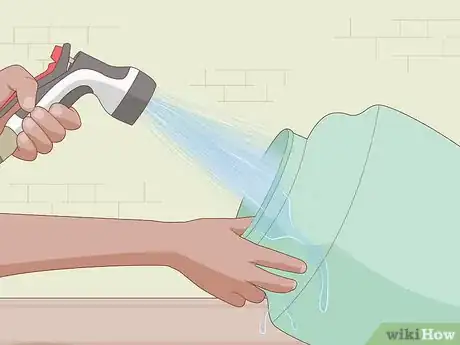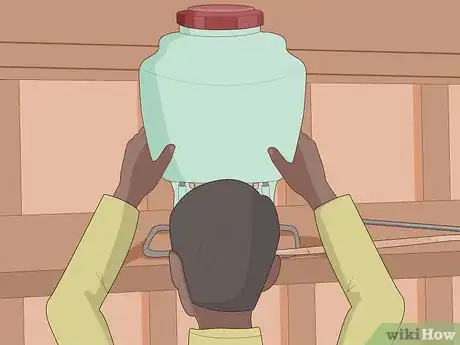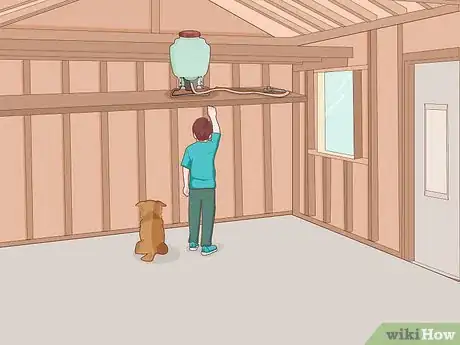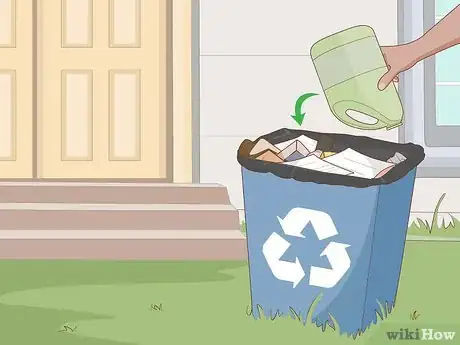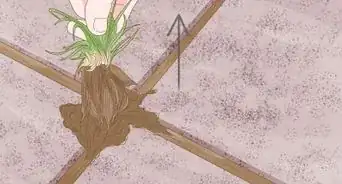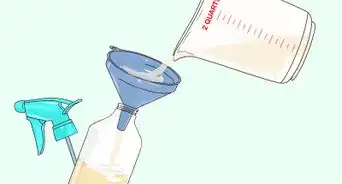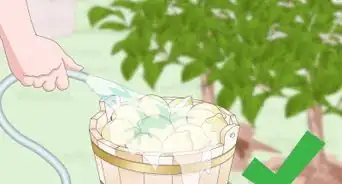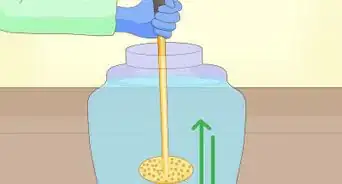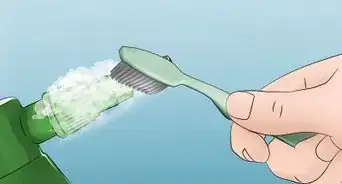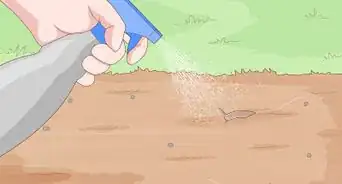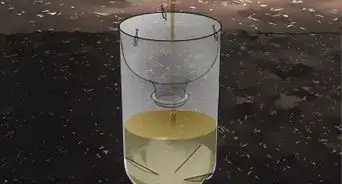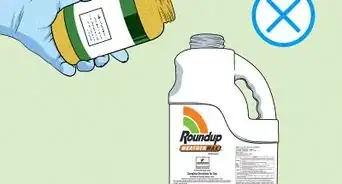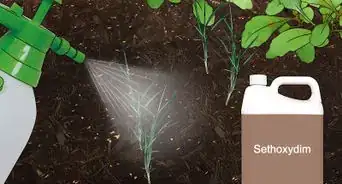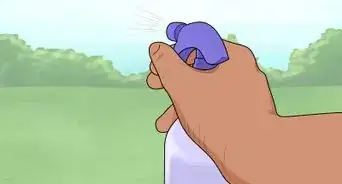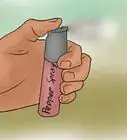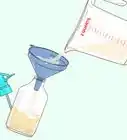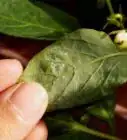This article was co-authored by wikiHow Staff. Our trained team of editors and researchers validate articles for accuracy and comprehensiveness. wikiHow's Content Management Team carefully monitors the work from our editorial staff to ensure that each article is backed by trusted research and meets our high quality standards.
There are 16 references cited in this article, which can be found at the bottom of the page.
This article has been viewed 43,056 times.
Learn more...
Roundup is a powerful herbicide that's great for eradicating weeds and other unwanted plants. If used incorrectly, however, the chemicals it contains could pose serious health risks. When applying Roundup in your yard or garden, make sure you're wearing long-sleeved clothing and thick rubber gloves to protect your skin. Place the weed killer in a spray or watering can and use the applicator to thoroughly wet the leaves of the plant you want to get rid of. Since Roundup can be dangerous, you'll want to store the chemical somewhere off limits to small children and pets when you're done.
Steps
Mixing the Concentrated Roundup Solution
-
1Wait for a clear, windless day to apply the herbicide. Excess precipitation can dilute the chemicals and make them less effective. Similarly, windy conditions could cause spray to drift toward other plants that you don't want to harm.[1]
- If there's a lot a dew on the ground in the mornings where you live, hold off on spraying until most or all of the moisture has dried.
- It may be necessary to reapply Roundup to an area you've previously treated if it rains within 6 hours afterwards.
-
2Equip yourself with the proper safety clothing. Change into some long-sleeved clothes that you don't mind getting dirty and wear thick rubber gloves to avoid getting any of the herbicide directly on your skin. You may also want to pull on a pair of waders or rain boots, which won't soak up the chemical and cause you to track it into your home.[2]
- It's important to take a few basic safety precautions to protect yourself from exposure to harmful chemicals anytime you're using a potent herbicide like Roundup.
Tip: While not a necessity, a facemask or ventilator can prevent you from breathing in the fumes emitted by the chemical.
Advertisement -
3Fill a tank sprayer or watering can with 1 gallon (3.8 L) of water. Remove the top from your applicator of choice and run clean water into it from a garden hose or other nearby water source. Refer to the measurement lines on your applicator to know when you've added just enough water.[3]
- All Roundup mixing directions are formulated around a base volume of 1 gallon (3.8 L).[4]
- If you need more or less solution, increase or decrease the amount of water you use in 1⁄4 gallon (0.95 L) increments and adjust the concentration of herbicide accordingly.
-
4Mix in the recommended concentration of Roundup. Follow the directions printed on the product's packaging to determine exactly how much concentrated Roundup to add. After funneling in the solution, place the lid back on your applicator and make sure it's properly secured. If you're using a sprayer, pump the handle repeatedly to thoroughly agitate the solution.[5]
- The instructions recommend using 3–6 fluid ounces (89–177 mL) of Roundup for every 1 gallon (3.8 L) of water, but you may be able to get away with using as little 1–2 fluid ounces (30–59 mL) to kill off small or sparse vegetation.[6]
- A sprayer will offer greater accuracy and allow you to only use as much herbicide as you need, while watering cans tend to be quicker and more convenient for treatments that cover a broad area.
Applying Roundup Effectively
-
1Wet the leaves of unwanted plants thoroughly. Spray or douse the foliage with a liberal amount of herbicide. You want to use enough to soak the leaves completely, but not enough to cause pooling or runoff. Do this for every part of your yard or garden where invasive plants are problem.[7]
- Targeting the leaves of the plant ensures that the chemicals get absorbed and make their way down to the roots, choking out the plant at its source.
- Over-applying Roundup isn't just wasteful, it could also put nearby desirable plants at risk.[8]
Tip: You can use Roundup on all actively growing plants, including weeds, grasses, shrubs, and even small trees.
-
2Wash or prune plants that you spray accidentally. If you happen to get Roundup on a plant that you don't want to eliminate from your yard or garden, pour clean water over the leaves repeatedly to wash off as much of the herbicide as possible. You can also snip off the affected foliage using a pair of hand shears or scissors.[9]
- Keep in mind that even a small amount of Roundup may be enough to severely weaken healthy plants.
-
3Wait 1-4 weeks for the targeted plants to die off. After applying Roundup in your yard or garden, you should notice it beginning to take effect within about a week. You'll know it's working when the edges of the leaves start to droop or wilt and become dry and brown.[10]
- Roundup works best on plants that are actively growing, so if the plant you sprayed has been stunted by winter weather or drought, it may take closer to 3 or 4 weeks before you see results.
-
4Apply a more powerful product if your unwanted plants don't stay gone. A single use should be enough to wipe out most plants. If you notice a targeted plant returning, however, or if a new one pops up in its place, it might help to treat the area again using an extended control formula. This will banish even the peskiest species for good.[11]
- Maximum strength and extended control products usually only need to be applied once a year to be effective.
Storing Roundup Safely
-
1Clean out your sprayer or watering can between uses. Drain any unused herbicide into an out-of-the-way patch of dirt or gravel, where it will bind to the soil and begin deteriorating. Fill your sprayer or watering can with clean water and agitate it before letting it sit for 5-10 minutes. Flush out the diluted chemicals by triggering or pouring out the applicator.[12]
- Cleaning an herbicide applicator can be messy work. Always gear up with gloves, eye protection, and waders or rain boots to protect yourself from misting and splashing.
- Glyphosate, the main chemical ingredient in Roundup, is water soluble and breaks down fairly quickly, so it's not necessary to use additional cleaning agents like ammonia or detergents.[13]
-
2Store your Roundup in a cool, dry place. The chemicals in Roundup will stay effective longest when kept at or around room temperature. In most cases, a garage or work shed will work just fine. You can also stash unopened herbicide under the sink or in a closet with your household cleaning products.[14]
- When stored correctly, concentrated Roundup can maintain its potency for as long as 2-3 years.
-
3Keep Roundup out of the reach of children and pets. Glyphosate can be toxic if inhaled or ingested. If you have inquisitive kids or fur babies at home, be sure to situate the container on a high shelf or put it away inside a cabinet, shed, or toolbox to keep them from getting into it.[15]
- Symptoms associated with exposure to unsafe levels of glyphosate include dizziness, skin irritation, nausea, vomiting, and diarrhea.[16]
Tip: If you think your child or pet might have come into contact with Roundup, call the Poison Control service for your area or get them to a hospital or veterinary clinic right away.
-
4Dispose of your empty Roundup container outside. When you've gone through the last of your Roundup, refill the bottle with clean water and shake it thoroughly to dilute any remaining chemical residue. Dump the contents in an open patch of soil, then replace the lid and deposit the bottle in an outdoor trash receptacle a safe distance away from your home.[17]
- Don't throw away an empty Roundup container indoors. Doing so could contaminate your trash with traces of the herbicide.
- Always use up an entire container before buying a new one to prevent chemicals from accumulating in your home.
Warnings
- Never dispose of excess herbicide or clean out your sprayer, watering can, or product container anywhere that your children or pets might venture.⧼thumbs_response⧽
- Whether or not Roundup is safe is the subject of much ongoing debate. Some studies claim to have linked its main ingredient, glyphosate, to serious health risks, including birth defects, Parkinson's Disease, Lou Gehrig's Disease, and bowel-related illness.[18]⧼thumbs_response⧽
Things You'll Need
- Roundup weed killer
- Manual or automatic tank sprayer
- Rubber gloves
- Waders or rain boots
- Long-sleeved clothing
- Clean water
- Watering can (optional)
- Facemask or respirator (optional)
References
- ↑ https://www.youtube.com/watch?v=BjGqRPCcee4&feature=youtu.be&t=11
- ↑ http://mikesbackyardnursery.com/2014/07/roundup-safe-use/
- ↑ https://www.youtube.com/watch?v=cKMLG7qy-rs&feature=youtu.be&t=36
- ↑ https://45ijagbx6du4albwj3e23cj1-wpengine.netdna-ssl.com/wp-content/uploads/Roundup-Original.pdf
- ↑ https://www.roundup.com/en-us/library/using-roundup-weed-grass-killer-products-properly/how-do-i-use-roundup-weed-grass-killer
- ↑ https://www.roundup.com/en-us/library/using-roundup-weed-grass-killer-products-properly/how-do-i-use-roundup-weed-grass-killer
- ↑ https://www.youtube.com/watch?v=BjGqRPCcee4&feature=youtu.be&t=44
- ↑ http://mikesbackyardnursery.com/2014/07/roundup-safe-use/
- ↑ https://www.youtube.com/watch?v=BjGqRPCcee4&feature=youtu.be&t=50
- ↑ https://www.roundup.com.au/faqs/why-arent-my-weeds-dead-yet
- ↑ https://www.youtube.com/watch?v=G56qB_fL-D4&feature=youtu.be&t=17
- ↑ https://sprayers101.com/an-easier-way-to-clean-your-sprayer/
- ↑ http://www.agphd.com/wp-content/uploads/2015/05/SPRAYER-TANK-CLEANOUT.pdf
- ↑ https://edis.ifas.ufl.edu/pdffiles/PI/PI16000.pdf
- ↑ https://www.roundup.com.au/faqs/can-i-keep-left-over-roundup-ready-to-use-until-next-year
- ↑ http://npic.orst.edu/factsheets/glyphogen.html
- ↑ https://www.youtube.com/watch?v=BjGqRPCcee4&feature=youtu.be&t=81
- ↑ https://www.yourgreenpal.com/blog/is-roundup-too-dangerous-for-personal-lawn-care-use
